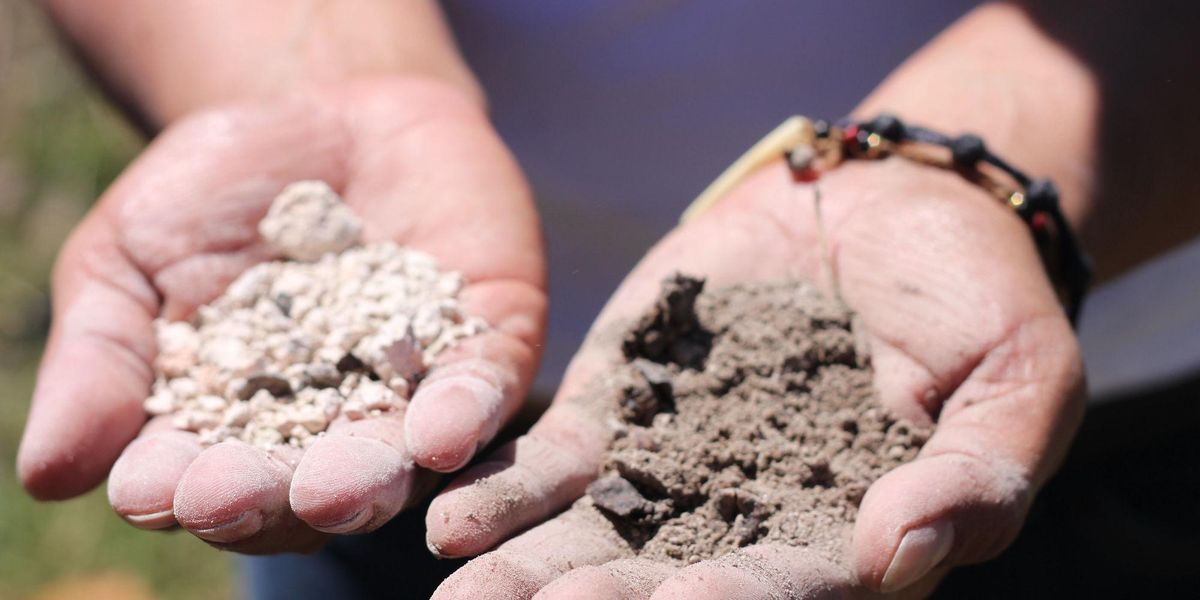
When Kegan Hilaire sent his mother, Maureen Hilaire, to get worm-poop fertilizer for their backyard garden in Bethlehem, Pennsylvania, last March, one shopping trip turned into two, one online research session followed by another.
The mother-son team had to make sure the products advertised as “organic” were in fact approved to use under the USDA organic standards.
“Maybe I’m just pessimistic, but I assume all of them are lying to me,” Kegan Hilaire, a city-dweller turned rookie farmer, told EHN. Transitioning his Blackbird Farms in Emmaus, Pennsylvania, to be USDA-certified organic in spring 2021, Hilaire considered the one-eighth-of-an-acre home garden as his practice field for organic production.
Costs of ‘organic’ confusion
Hilaire has to be vigilant. The USDA currently does not regulate “organic” labels on farming supplies such as fertilizers. “Just seeing the word organic doesn’t necessarily mean it is an [approved] organic input material,” Stephen McMurry, who chairs the Terms and Definitions Committee at the Association of American Plant Food Officials, an organization that makes legislative recommendations for fertilizers, told EHN. Regardless, if Hilaire applies a prohibited fertilizing product — even unintentionally — to his farm, he will suffer a three-year delay in organic certification.
“If you went to the grocery store right now, you would know exactly which products are organic, and which products are not organic,” Emily Newman, an organic consultant at the Rodale Institute, a non-profit organization for organic research and education, told EHN. However, when it comes to farming products, organic labeling is on a “completely different end,” says Newman.
The word “organic” in fertilizers simply means the product comes from “a living thing that contains a nutrient, whether it is nitrogen, phosphorus, or potash,” says McMurry. One example is fertilizers made of biosolids — recycled and treated sewage sludge. Although these products are chemically “organic” and are often advertised as “organic”, they are prohibited in organic food production.
Newman, who works with conventional farmers who are transitioning to obtain USDA organic certification, says the unsynchronized definitions of “organic” can mislead some farmers. She says she knows two farms that had applied a prohibited substance accidentally, delaying their transitions.
Simply put, “if you’re a crop farmer, and you’ve applied a prohibited substance last year, you need to transition for two more years,” Jen Berkebile, who reviews organic compatibility for farming materials at Pennsylvania Certified Organic, a USDA-accredited certifying agency, told EHN.
Losing certification can have “incredible financial implications,” David Muehleisen, an organic agriculture professor at the Evergreen State College in Washington, who supervises a three-acre USDA-certified organic farm on campus, told EHN. “If you lose your certification, all of a sudden (you) can’t call your product organic — you’re losing that premium,” Andrew Lawson, the head grower at Appleton Farms, a certified organic farm located in Ipswich, MA, told EHN.
The organic premium
For farmers, the USDA organic label can be as gold as it is green. The USDA Economic Research Service shows that among 17 commonly purchased organic products — from eggs to granola — all but spinach had 20% higher premiums than their conventional counterparts from 2004 to 2010. Organic eggs and yogurt charged even higher prices in 2010 — 82% and 50% more expensive, respectively. Overall, sales of organic commodities have increased by 31% from 2016 to 2019, according to the 2019 USDA Organic Survey.
However, obtaining USDA certification can be difficult. For one, farmers often have to pay at least $1,000 per year in inspection and certification fees. Additionally, although farmers adhere to the USDA organic standards for at least 36 months during the transition, farmers cannot sell or market their product as certified organic, imposing a financial burden during that waiting period.
Even so, farming organically is still lucrative. A 2015 global analysis of organic farms by researchers at Washington State University showed that despite the higher production cost, the profit margin for organic farms is significantly higher (22–35%) than conventional ones, bringing farmers economic benefits. Despite the challenges, by 2019, more than 16,000 farms have obtained USDA organic certification, tripling how many there were in 2008, when the first national organic survey was conducted by the USDA.
Helping farmers navigate the “Wild Wild West” of fertilizers
Some resources do exist to help farmers determine whether a product is approved for use on organic farms. The National Organic Program maintains the National List of Allowed and Prohibited Substances, regulating the substances used in organic agriculture. However, “[the list] was not set up with brand names in mind,” Lillie Weiya Zeng, a spokesperson for USDA, told EHN in an email. In other words, the list offers little guidance when a farmer is going through a farm supply catalog (imagine if the FDA only approved drug ingredients instead of drug brands). That has created space for the Organic Materials Review Institute (OMRI), a third-party independent non-profit organization based in Eugene, Oregon, that reviews organic input materials.
“My impression is that OMRI was very much born out of the frustration of the certifiers that founded it,” Meghan Murphy, Marketing Manager of the OMRI, told EHN. Established in 1997, OMRI provides review services to input products — from fertilizers to pest control materials to livestock healthcare products — to determine if they adhere to the USDA organic standards (OMRI also reviews products for Mexican and Canadian organic standards).
However, Murphy emphasizes that OMRI is not a certifying agency nor a regulatory organization — it simply provides review services for companies that choose to apply. To receive an OMRI review, input material manufacturers voluntarily submit their product information and pay a review cost on a sliding scale — ranging from about $500 to more than $6000. If their product is approved, the manufacturer can use the OMRI seal on the package.
Besides OMRI, some states, such as the Washington State Department of Agriculture and the California Department of Food and Agriculture also maintain their own lists of registered input materials for organic food production. However, William Horwath, the chair of the Soil Biogeochemistry department at the University of California Davis, told EHN he fears that these lists may not be foolproof — only reviewing voluntarily submitted information by manufacturers without conducting extensive laboratory testing can be “sort of a rubber stamp.”
In the early 2010s, Horwath was tasked by the California Department of Agriculture to develop methods to test the authenticity of organic fertilizers. He was brought on shortly after a scandal where a California-based fertilizer company spiked their liquid “organic” fertilizer with ammonium chloride, a prohibited synthetic material for organic use, and submitted fraudulent information to OMRI.
To that end, Horwath helped create laboratory tests, based on the carbon-to-nitrogen ratio of a fertilizer product and how “heavy” the nitrogen atoms are. Simply put, natural materials tend to have higher carbon-to-nitrogen ratios and heavier nitrogen atoms than synthetic nitrogen. However, Horwath says these tests can be expensive and require elaborate equipment — the kind even state labs might not have. So, adulterations in organic fertilizers can remain undetected in what he calls “the Wild Wild West.”
Even so, some organic farmers find the OMRI labels helpful. “I always look for that label. If it doesn’t have a label. I will not use it,” says Andrew Lawson, the Massachusetts farmer. Dina Brewster, an organic farmer at The Hickories farm at Ridgefield, Connecticut agrees. “I learned very quickly early on as a farmer it has to say OMRI listed,” she told EHN.
The California example

Although most states do not regulate organic labeling on input materials, California — the state with the largest number of certified organic farms — is an exception. It provides some regulations on “organic” labeling on input materials. According to the California state fertilizer laws and regulations, manufacturers can only use the word “organic” to describe their product if it is made entirely from plant or animal sources.
Additionally, all fertilizers sold in California for use in organic food production are required to be registered with the state’s Organic Input Material program. If a labeled “organic” material is not registered for organic use, it needs a disclaimer stating the product is “not for use in organic crop and organic food production.” It is unclear, though, how the state is enforcing such regulations and what the penalties are. The California Organic Input Material program officials have not yet responded to interview requests.
It is hard to assess exactly how many farmers have lost their organic certifications to misleading organic labels nationwide due to the lack of data. Don Franczyk, the Executive Director of Baystate Organic Certifiers, a USDA National Organic Program-accredited certifying agency, thinks farmers losing organic certifications by using misleading “organic” inputs is not a “system-wide problem.” Franczyk sees beginning farmers and home gardeners as people who are most often “tricked by those organic labels.” “I feel so bad for gardeners because it’s marketed to them as if everything’s great,” he told EHN.
But it’s the commercial farmers who suffer the most if they make a mistake. Therefore, if farmers use the wrong product, then “it is a problem” for their livelihood, says Muehleisen, the organic production professor at Evergreen State College. Because of the potentially massive consequences, Muehleisen says he always teaches his students to ask the organic certifiers, “is this product still good? Am I allowed to use it?”
Banner photo credit: Counter Culture Coffee/flickr





